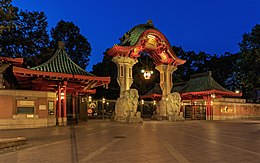Berlin Zoologischer Garten

The Elephant Gate: one of two zoo entrances
|
|
| Date opened | 1844 |
|---|---|
| Location | Berlin, Germany |
| Coordinates | 52°30′30″N 13°20′15″E / 52.50833°N 13.33750°ECoordinates: 52°30′30″N 13°20′15″E / 52.50833°N 13.33750°E |
| Land area | 35 hectares (86.5 acres) |
| No. of animals | 18,662 (December 2016) |
| No. of species | 1,380 (December 2016) |
| Annual visitors | More than 3.3 million (2015) |
| Memberships | EAZA,WAZA |
| Director | Andreas Knieriem |
| Website | zoo-berlin.de/ |
The Berlin Zoological Garden (German: Zoologischer Garten Berlin) is the oldest and best known zoo in Germany. Opened in 1844 it covers 35 hectares (86.5 acres) and is located in Berlin's Tiergarten. With about 1,380 different species and over 19,400 animals the zoo presents one of the most comprehensive collection of species in the world.
The zoo and its aquarium had more than 3.3 million visitors in 2015. It is considered to be the most visited zoo in Europe and one of the most popular worldwide. Regular animal feedings are among its most famous attractions. Globally known animals like Knut, the polar bear, and Bao Bao, the giant panda have contributed to the zoo's public image.
The zoo collaborates with many universities, research institutes, and other zoos around the world. It maintains and promotes European breeding programmes, helps safeguard several endangered species, and participates in several species reintroduction programs.
Opened on 1 August 1844, the Zoologischer Garten Berlin was the first zoo in Germany. The aquarium opened in 1913. The first animals were donated by Frederick William IV, King of Prussia, from the menagerie and pheasantry of the Tiergarten.
In 1938, the Berlin Zoo got rid of Jewish board members and forced Jewish shareholders to sell their stocks at a loss, before re-selling the stocks in an effort to "Aryanize" the institution. The zoo has now commissioned a historian to identify these past shareholders and track down their descendants, according to a report by AFP.
During World War II, the zoo area was completely destroyed and only 91 of 3,715 animals survived, including two lions, two hyenas, an Asian bull elephant, a hippo bull, ten hamadryas baboons, a chimpanzee, and a black stork. By the end of the war, the zoo was fortified with the Zoo flak tower, a huge flak tower that was one of the last remaining areas of German resistance against the Red Army, with its bunkers and anti-aircraft weapons defending against allied air forces. Following the zoo's destruction, it and the associated Aquarium was reconstructed on the most modern principles so as to display the animals in as close to their natural environment as feasible. The success achieved in breeding animals, including some rare species, demonstrates the efficacy of these new methods.
...
Wikipedia
